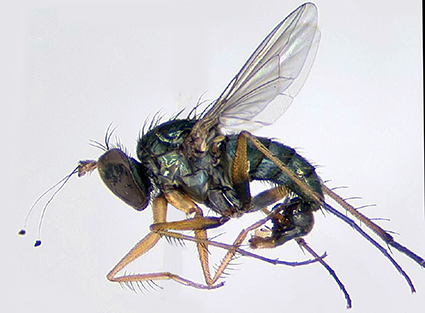Abstract
A tylenchid nematode parasite of a male long-legged fly, Tachytrechus sanus Osten Sacken (Diptera: Dolichopodidae) from Montana, USA is described as Parasitylenchus myiophagus n. sp. (Nematoda: Parasitylenchidae). The new species is characterized by the presence of an extremely long first generation female and numerous short and wide second generation males and females produced in “enclosed” clusters in the host’s body cavity. Both generation female nematodes are ovoviviparous, with short stylets lacking knobs and simple tails lacking spikes, palps or mucrons. The second generation males have paired, separate spicules, short stylets, and a bursa but no visible gubernaculum. The fly host shows evidence of demasculinization, which is attributed to nematode parasitism. The gonads of the second generation adults are infected with a microsporidium (Microsporidia), which is a new host record for tylenchid nematodes. A tylenchid-infected Baltic amber dolichopodid shows that associations between these two organisms extend back at least to the Eocene.
References
Bickel, D.J. (2009) Family Dolichopodidae. In: Brown, B.V., Borkent, A., Cumming, J.M., Wood, D.M., Woodley, N.E. & Zumbado, M.A. (Eds.) Manual of Central American Diptera. Vol. 1. NRC Press, Ottawa, pp. 671–694.
Dollfus, R. Ph. (1946) Parasites des Helminthes. Encyclopédie Biologique, 27, 1–482.
Germann, C., Kahanpää, J., Pollet, M., Pollini, L. & Bernasconi, M.V. (2010) The synonymies of Dolichopus lepidus lepidus Staeger, 1842 – demasculinisations, lectotype designations and a nomen oblitum (Diptera, Dolichopodidae). Zootaxa, 2560 (1), 51–60. https://doi.org/10.11646/zootaxa.2560.1.5
Hedström, L. (1976) Dolichopodidae (Diptera). Fauna of the Hardangervidda, 9, 13–21.
Kahanpää, J. (2008) Nematode-induced demasculinisation of Dolichopus males (Diptera: Dolichopodidae). Zootaxa, 1689 (1), 51–62. https://doi.org/10.11646/zootaxa.1689.1.3
Kudo, R. (1966) Protozoology (Fifth Edition). Charles C. Thomas, Springfield, Illinois.
Micoletzky, H. (1922) Die freilebenden Erd-Nematoden. Archive fur Naturgeschichte, Abteilung A, 87, 1–650.
Osten Sacken, C.R. (1877) Western Diptera: Descriptions of new genera and species of Diptera from the region west of the Mississippi and especially from California. Bulletin of the United States Geological and Geographical Survey of the Territories, 3, 189–354. https://doi.org/10.5962/bhl.title.57939
Poinar Jr., G.O. (1975) Entomogenous nematodes: a manual and host list of insect-nematode associations. E. J. Brill, Leiden, 317 pp.
Poinar Jr., G.O. (1992) Life in amber. Stanford University Press, Stanford, California, xvi + 350 pp.
Poinar Jr., G.O. & Brown, A.E. (2021) Palaeoparasitylenchus balticus n. sp. (Nematoda: Parasitylenchidae), a nematode parasite of a long-legged fly (Diptera: Dolichopodidae) in Baltic amber. Nematology. [published online] https://doi.org/10.1163/15685411-bja10117
Poinar Jr., G.O. & Milki, R. (2001) Lebanese amber. The oldest insect ecosystem in fossilized resin. Oregon State University Press, Corvallis, Oregon, 96 pp.
Poinar Jr., G.O., Jaenike, J. & Dombeck, I. (1997) Parasitylenchus nearcticus sp. n. (Tylenchida: Allontonematidae) parasitizing Drosophila (Diptera: Drosophilidae) in North America. Fundamental and Applied Nematology, 20, 187–190.
Robinson, H. & Vockeroth, J.R. (1981) Dolichopodidae. In: McAlpine, J.F., Peterson, B.V., Shewell, G.E., Teskey, H.J., Vockeroth, J.R. & Wood, D.M. (Coords.), Manual of Nearctic Diptera. Vol. 1. Research Branch, Agriculture Canada, Ottawa, Ontario, pp. 625–639.
Runyon, J.B. Nematode-induced demasculinization of Nearctic Dolichopodidae (Diptera) and five new synonyms. Zootaxa. [in review]
Siddiqi, M.R. (1986) Tylenchida: Parasites of plants and insects. Published by Commonwealth Institute of Parasitology of the Commonwealth Agricultural Bureau, London, 645 pp.
Siddiqi, M.R. (2000) Tylenchida: Parasites of plants and insects. 2nd Edition. CABI Publishing, Wallingford, 833 pp. https://doi.org/10.1079/9780851992020.0000
Sprague, V. (1977) The zoological distribution of the Microsporidia. In: Sprague, V. (Ed.), Systematics of the Microsporida. Comparative Pathobiology. Vol. 2. Plenum Press, New York, pp. 335–385. https://doi.org/10.1007/978-1-4613-4205-2_3
Ulrich, H. (2004) Predation by adult Dolichopodidae (Diptera): a review of literature with an annotated prey-predator list. Studia dipterologica, 11, 369–403.
Undeen, A.H. & Maddox, J.V. (1973) The infection of non-mosquito hosts by injection with spores of the microsporidian Nosema algerae. Journal of Invertebrate Pathology, 22, 258–265. https://doi.org/10.1016/0022-2011(73)90143-2
Welch, H.E. (1959) Taxonomy, life cycle, development, and habits of two new species of Allantonematidae (Nematoda) parasitic in drosophilid flies. Parasitology, 49, 83–103. https://doi.org/10.1017/S003118200002672X
Wolfe, A.P., McKellar, R.C., Tappert, R., Sodhi, R.N.S. & Muehlenbachs, K. (2016) Bitterfeld amber is not Baltic amber: three geochemical tests and further constraints on the botanical affinities of succinite. Review of Palaeobotany and Palynology, 225, 21–32. https://doi.org/10.1016/j.revpalbo.2015.11.002


